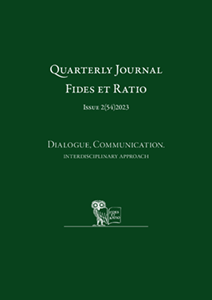Abstract
Communication–as the transmission of information (message) between people, is an essential element of family life. The interpersonality–the relationality of family communication and the systemicity–the functioning of the individual within the subsystems husband-wife, parent-child and child-child should be emphasized. The realities of everyday life, including the cohabitation of family members, imply the frequency, intensity and regularity of communication processes. Abnormal communication implies disruptions in the functioning of the family. An extreme manifestation of such disruptions will be the committing of criminal offences. The aim of the article is to identify and characterize the most important criminal-law aspects of family communication–from the perspective of substantive criminal law. Family communication may be an element of the causative activity of crimes under the Criminal Code. In particular, it is necessary to mention crimes against the family and custody: bigamy (article 206 of the Criminal Code), domestic violence (article 207 of the Criminal Code) and debauching a minor (article 208 of the Criminal Code), as well as a crime against life and health–euthanasia (article 150 of the Criminal Code). The subjects of proceedings will be: declarations of intent by people entering into a marriage (the crime of bigamy); threats, bullying and insults carried out by perpetrators of domestic violence; incitement of minors to consume alcohol (by parents or legal guardians), as well as demands and requests whose object is the will to end life (in the case of euthanasia). Criminally relevant is the context and the relationship of the communication participants–especially the husband (father) as sender in the husband-wife and parent-child communication process. The intensity, persistence and frequency of family communication processes, resulting from cohabitation and other life realities, affect the specificity of the incriminated actions. The analysis of family communication may influence the finding of the accused guilty or the legal qualification of the action. As an example, consider the problem of defining a communication as a request or demand when it is necessary to decide whether the crime of euthanasia has been committed.
References
Barbaro, B. de (red.) (1999). Wprowadzenie do systemowego rozumienia rodziny. Kraków: Wydawnictwo UJ.
Braun-Gałkowska, M. (2008). Psychologia domowa. Lublin: Wydawnictwo KUL.
Bejma, U. (2014). Komunikacja interpersonalna a konflikty w rodzinie. Studia nad Rodziną, 1(34), 157-172. https://doi.org/10.21697/snr.2014.34.1.10.
Cotterill, J. (2003). Language and Power: A linguistic analysis of the O.J. Simpson trial. Basingstoke: Palgrave Macmillan.
Demenko, A. (2021). Przestępstwa popełniane przez wypowiedź. Warszawa: Wydawnictwo C.H. Beck.
Filipiak, M. (2004). Homo Communicans. Wprowadzenie do teorii masowego komunikowania. Lublin: Wydawnictwo Uniwersytetu Marii Curie-Skłodowskiej.
Gardocki, L. (2019). Prawo karne. Warszawa: Wydawnictwo C.H. Beck.
Harwas-Napierała, B. (2006). Komunikacja w rodzinie ujmowanej jako system w relacji rodzice – dzieci. Roczniki Socjologii Rodziny, tom XVII, 221-233.
Hypś, S. (2023a). Art. 206 KK. (W:) M. Królikowski, R. Zawłocki (red.), Kodeks karny. Część szczególna. Komentarz do artykułów 117–221. Warszawa: Wydawnictwo C.H. Beck.
Hypś, S. (2023b). Art. 207 KK. (W:) M. Królikowski, R. Zawłocki (red.), Kodeks karny. Część szczególna. Komentarz do artykułów 117–221. Warszawa: Wydawnictwo C.H. Beck.
Hypś, S. (2023c). Art. 208 KK. (W:) M. Królikowski, R. Zawłocki (red.), Kodeks karny. Część szczególna. Komentarz do artykułów 117–221. Warszawa: Wydawnictwo C.H. Beck.
Jakubiec, S. (2011). Mediacje jako metoda pracy z rodziną. Kraków: Wydawnictwo WSFP Ignatianum.
Kokot, R. (2023). Art. 150 KK. (W:) R.A. Stefański (red.), Kodeks karny. Komentarz. Warszawa: Wydawnictwo C.H. Beck.
Komorowska-Pudło, M., Sameluk, A. (2022). Communication between parents and their adult children’s value system. Kwartalnik Naukowy Fides et Ratio, 1(49), 89-98. https://doi.org/10.34766/fetr.v49i1.1057
Kosonoga, J. (2023). Art. 207 KK. (W:) R.A. Stefański (red.), Kodeks karny. Komentarz. Warszawa: Wydawnictwo C.H. Beck.
Matyjas, B. (2017). Komunikacja w rodzinie – modele, style, bariery. Warmińsko-Mazurski Kwartalnik Naukowy, Nauki Społeczne, 4(24), 38-49.
Pankalla, A. (2000). Psychologia mitu. Kultury tradycyjne a współczesność. Warszawa: Eneteia.
Pankalla, A., Kośnik, K.K. (2018). Indygeniczna psychologia Słowian. Wprowadzenie do realnej nauki o duszy. Kraków: Universitas.
Pankalla, O. (2022). Językoznawstwo sądowe w polskim postępowaniu karnym. (W:) A.S. Dyszak, K. Kołatka (red.), Polszczyzna w różnych jej aspektach. Miscellanea lingwistyczne i varia, 169-185, Bydgoszcz: Wydawnictwo UKW.
Ryś, M. (2020). Poczucie własnej wartości i odporność psychiczna osób wzrastających w różnych systemach rodzinnych. Warszawa: Wydawnictwo Naukowe UKSW.
Tobis, A. (1980). Główne przestępstwa przeciwko rodzinie: charakterystyka prawna i skuteczność kary pozbawienia wolności. Poznań: Wydawnictwo Naukowe UAM.
Weare, S. (2017). Bad, Mad or Sad? Legal Language, Narratives, and Identity Constructions of Women Who Kill their Children in England and Wales. International Journal for the Semiotics of Law–Revue internationale de Sémiotique juridique, 30, 201–222. https://doi.org/10.1007/s11196-016-9480-y

